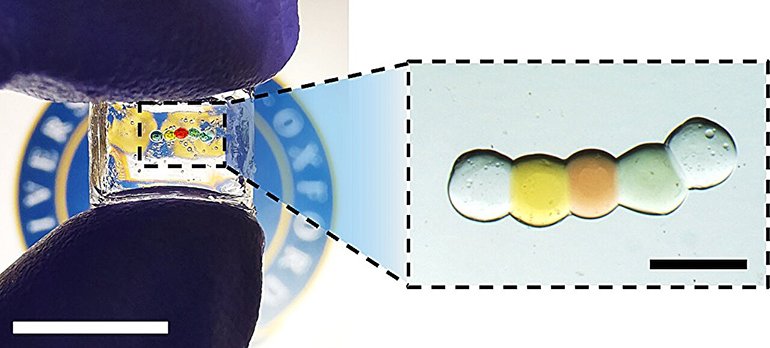Researchers at Oxford University have developed a tiny battery that can power small implantable devices, such as drug delivery technologies. The new battery is inspired by the ionic gradients that electric eels use to generate electricity. It involves tiny droplets of a conductive hydrogel that are placed near each other. Each droplet has a different ionic concentration, meaning that ions will flow from high concentration droplets to low concentration droplets. When the researchers connect electrodes to this chain of droplets they can harness the energy generated by this ion gradient in the form of electricity. The researchers can print large arrays of these nanodroplets, allowing them to customize the technology to suit a range of implantable devices with different space restrictions and power needs.
Tiny medical implants could find use in a wide variety of applications, from drug delivery to neural stimulation. However, there is a constant challenge inherent to creating such devices, which is creating safe and effective power sources. Traditional batteries are often too bulky for use in tiny bioelectronic devices, and also pose safety concerns if they leaked or were damaged in the body.
To address this, these researchers took inspiration from the electric eel, which uses ion gradients to create electricity. The Oxford team used a chain of hydrogel droplets with a differing ion concentration in each drop to create a similar ion gradient. When the ions flow across the drops they generate energy, and simply attaching electrodes to each end of the chain is enough to harness this in the form of electric current.
“The miniaturized soft power source represents a breakthrough in bio-integrated devices,” said Yujia Zhang, a researcher involved in the study. “By harnessing ion gradients, we have developed a miniature, biocompatible system for regulating cells and tissues on the microscale, which opens up a wide range of potential applications in biology and medicine.”
One of the key strengths of the system is its modular nature, whereby the researchers can print different arrays and arrangements of droplets to power different devices. For instance, by combining 20 sets of five droplets together in series, the researchers could power an LED light which requires 2 Volts.
‘This work addresses the important question of how stimulation produced by soft, biocompatible devices can be coupled with living cells,” said Hagan Bayley, another researcher involved in the study. “The potential impact on devices including bio-hybrid interfaces, implants, and microrobots is substantial.’
Study in journal Nature: A microscale soft ionic power source modulates neuronal network activity
Via: Oxford

